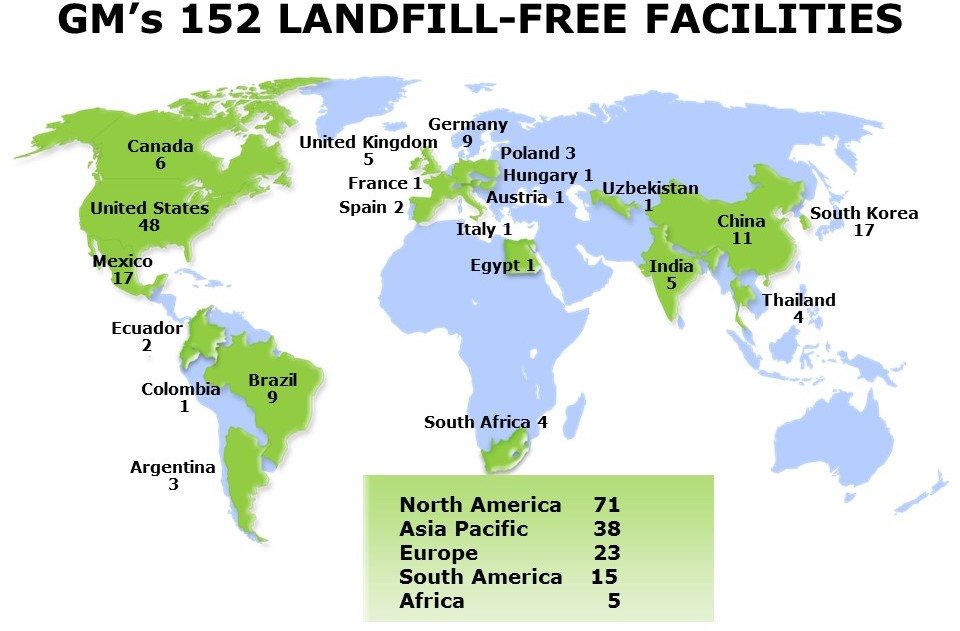
By John Bradburn, Global Waste Reduction Manager, General Motors
GM achieved a record number of landfill-free facilities last year, exceeding our commitment four years early. We now have 152 global facilities that recycle, reuse or convert to energy all daily waste. The 23 new sites added in 2016 are in Asia, Africa, North America and South America.
Whether it’s recycling Flint water bottles into engine cover insulation or turning Mississippi River tires into air-deflecting car baffles, we’re working together with suppliers to advance a more circular economy where materials are kept in use. We set an aspirational goal to become a zero-waste manufacturer, and we’re over halfway there with 100 manufacturing facilities that are landfill-free. The other landfill-free facilities are non-manufacturing operations such as technical centers and offices.
GM views sustainability as a business approach that looks at ways to grow and strengthen the business for the long term.
Sustainability and environmental performance reflect a solid business model for any company, regardless of what it builds or services it provides. More companies now understand the top and bottom line effects of reducing waste.
GM has generated up to $1 billion from recycling in recent years; money we reinvest into development of fuel-efficient vehicles and new technologies shaping the future of mobility. There’s also the added operational efficiency and elimination of waste-hauling fees.
Just how much trash are we talking? In a year, we recycle or reuse over 2 million metric tons of byproducts. Put differently, if someone were to place that material into the beds of Chevrolet Silverado extended-cab pickup trucks and park them end to end, they would stretch around the world.
Companies of all sizes and industries can reduce waste and create efficiencies. Below are eight tips that can help organizations get to zero.
- Track waste data and set goals and metrics for each facility. The goal is to eliminate, reuse and recycle, leaving expensive energy conversion as a last resort for challenging materials.
- Engage employees as stakeholders in the initiative. Foster a culture where waste is just a resource out of place.
- Hire onsite resource managers with compliance and waste-minimization expertise.
- Strengthen supplier relationships and build a network of companies committed to keeping materials in use. Collaborate to turn project ideas into reality.
- Rethink product design to avoid scrap. Where possible, make material substitutions and process changes to improve recyclability and design out inefficiencies.
- Set up a reporting system that allows the global sharing of lessons learned. This can mean global conference calls with company experts from each region to share best practices and meetings focused on specific commodities with resource managers and suppliers. Communicate successful processes and technologies for greater implementation.
- Manage the landfill-free process through a single corporate entity to ensure consistency and build subject matter expertise.
- Share best practices with other organizations and work together to brainstorm uses for challenging byproducts. Many companies deal with the same waste streams, from packaging to paper and metals.
Through collaboration, companies are learning about various technology options to keep materials in use. We often go to multiple sources, and at times, facilitate the collaboration among various companies to manage a particular waste stream. It’s about connecting the green dots that improve company efficiency. This networking and sharing serves to build a robust recycling and reuse infrastructure and further strengthen the companies involved.
The future will increasingly involve seeking out these byproduct synergies and materials matchmaking among companies. After all, one company’s output can be another company’s raw material, thus potentially saving money while reducing environmental impact.
____________

John is manager of global waste reduction at General Motors. In this role, he leads the company’s landfill-free initiative, which has resulted in 152 GM operations around the world that reuse, recycle, and convert to energy all waste from daily operations. John is an expert in waste reduction and recycling, and is dubbed GM’s MacGyver for devising unconventional uses for everyday waste. He frequently mentors other companies pursuing zero-waste goals. John’s responsibilities also include directing GM’s design-for-the-environment program, implementing sustainable processes and technologies that reduce environmental impact and costs.
